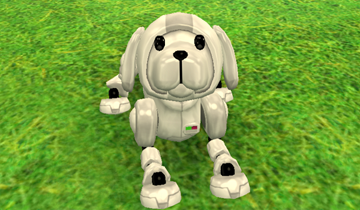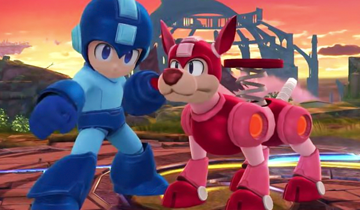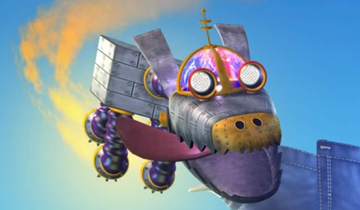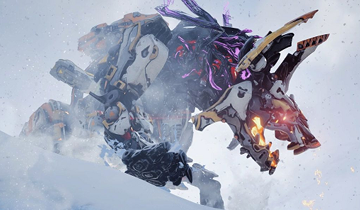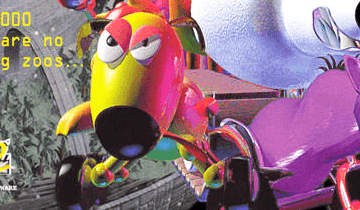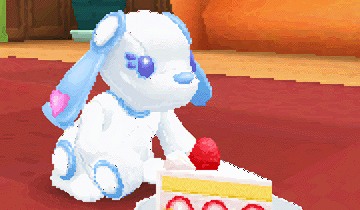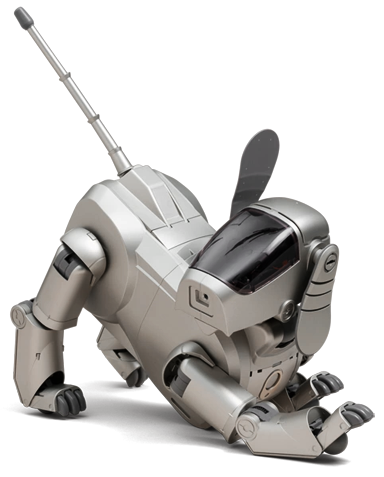In the simplest terms, AIBO are robot dogs. They come in a variety of breeds, known as models, and must be cared for as they grow in order to develop well-rounded, interactive personalities. On this page, I've put together a short biography on every known model of AIBO, as well as some simple care guides and other references related to their history.
I'm not a professional, but I am passionate, and this page is an accumulation of that passion!
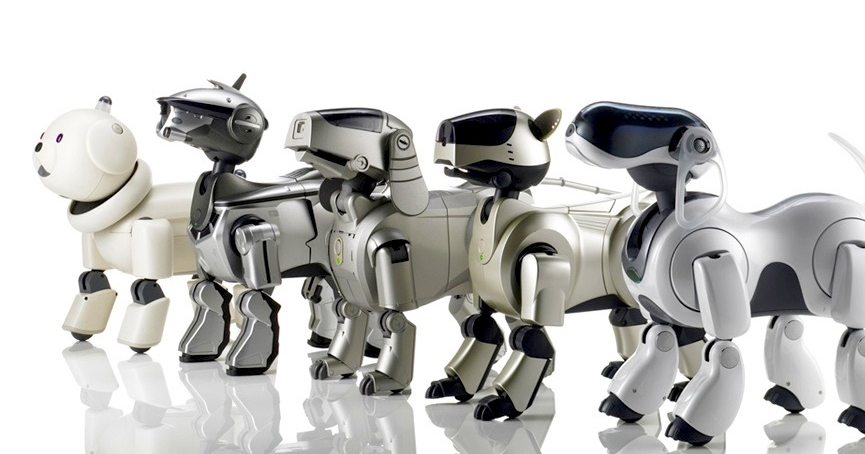
For a more comprehensive archive of information, I recommend visiting the AIBO Wiki on Miraheze.
A prototype is a preliminary version of a device from which other forms are developed. These are often experimental and unrefined, making them appear unique and act with a lot of quirks.
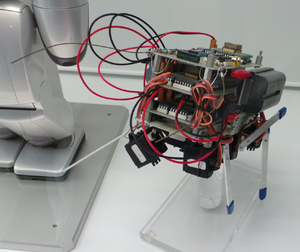
Designed in 1994 by Masahiro Fujita, MUTANT was the first AIBO prototype and the first entry in Sony's entertainment robotics presence. It was modeled after Genghis, a six-legged bug-like MIT robot which became famous for its advancements in locomotion.
MUTANT was completed in just two weeks and made no effort to emulate the behaviour of a dog as Sony had yet to determine AIBO's place in the home. Still, it was an enrapturing little creature.
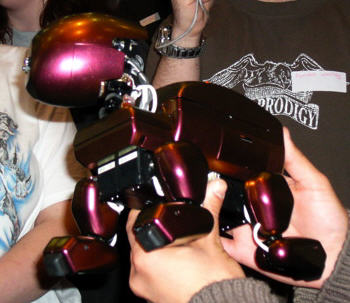
Nicknamed robodog, modeled after a monkey and created with both home and research markets in mind, the 1997-1998 prototype shaped the AIBO we know today. It had a colour video camera, a stereo microphone, a mono speaker, and 16 degrees of freedom - 3 in each leg, 3 in the head, and 1 in its tail. It also pioneered the modularity present in ERS-110, suggesting it may have used an early version of OPEN-R.
It was known to have three internal applications: a Pet Robot application pre-programmed with 250 behaviours, a Soccer Boy mode with ball recognition and gameplay, and Motion Lock for posing and general demonstration.
With the project set to appeal to a consumer market, Sony stated that the 1998 prototype was created for those who wanted a pet but didn't have the time to take care of one. It was predicted the robot would be available by 2000 and would be available in a range of colours from silver, black and white to violet chrome and metallic brown.

The ERS-210 owned by AIBO Ranch is the earliest example of a prototype ERS-210 known to the community. The core and especially the battery compartment has many distinct differences from the final model - most notably, the memory stick reader is housed differently and appears to be handmade. Inside the compartment is a yellow sticker that reads 138, which is speculated to be its serial number.
It also has an earlier design for the faceplate, with a much straighter curve to its green lights and skinnier outlines.
0000041 is a Swedish ERS-210 with a unique core and variant modules. Not much is known about it as it has no production labelling and is named only for its serial number.
Onsei Ninshiki, also known as Voice Recognition Demo, is a prototype owned by JBurg who was named for the unique software that accompanied him. His chin sensor is missing the nub that was added to assist owners in finding its placement on the jaw, and his tail hub is said to do a bad job of holding his tail on.
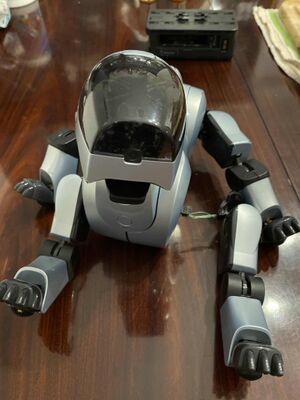
Owned by aibo7m3, Buster is believed to be a prototype that was used for stress testing due to his questionable construction and the extreme amounts of wear on his body.
His hip joints protrude from his leg sockets, green wires are exposed on his knees, and his internal cables are located in places where it would be easy for them to fray and break with ordinary use. At a glance, the construction of his chin sensor and tail hub appear to be the same as the Voice Recognition Demo prototype, and though his faceplate seems ordinary, the covers for his lights aren't frosted - meaning his circuit board can be seen through his eyes.
There are also stickers all over his body. The one on his core reads 168, while his limbs range from 159-168.
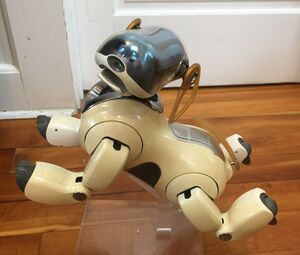
Gambit is the only documented ERS-7 prototype and contains a small goldmine of production data. Accompanied by a prototype version of the MIND software, his memory stick contains pictures of Sony engineers and conference rooms, as well as extended collections of sound work from Masuya Matsuura - the musician behind AIBO, Parappa the Rapper, Um Jammer Lammy and Vib Ribbon.
Despite being dated only 3 months prior to the official release of ERS-7, Gambit sports a few cosmetic changes. For example, his neck plate is chrome rather than matte black, and the plastic shield located in front of his chest is entirely transparent. His tail is also missing the metal nubs that keep ERS-7's tail from flying off.
His battery compartment has no production labelling, but it is heavily stickered in comparison to older prototypes.

The first commercial AIBO and an immediate smash hit, sales for the ERS-110 began in June 1999 and sold out just 20 minutes after launch! It set the stage and the standard for the future of robotic dogs with its imaginitive design, boasting complex artificial intelligence and an array of physical details that truly breathed life into its metal body. Thanks to no less than eighteen types of joints in the leg, neck, tail and upper jaw of the robot, it's an incredibly expressive pet with the ability to learn from the emotions of its owners.
The design of the model takes after the beagle, having a stout overall appearance and a broad head with a short muzzle. Its ears are low-set and rounded and its tail is segmented into four long pieces, coming to a blackened tip known as a flag. It has a charming black visor and four characteristic fang-points on the chassis of its head, which adds some puppylike mischief to the design. Unlike future models, it is an off-silver warm colour and sports darkened joints and toes.
It also has a vent on its back, meaning its look can only be customised if it is cut open.
The revision of the ERS-110 is the ERS-111, an almost identical model of robot with stronger leg joints and two official colours - silver and black.
ERS-11X, like all AIBO, is capable of learning and growing as it interacts with its owners. Thanks to its software, it starts out as a puppy and grows to an adult through evolution parameters - meaning as it interacts more with its owners and its surroundings, it learns new emotions and new ways to behave! Its personality is uniquely sculpted by the experiences it has and it will learn right from wrong according to the praise and scolding of its owner. It also incorperates various sensors and autonomous programs that enable it to behave like a non-robot dog, reacting to external stimuli and acting on its own judgement.
Unlike later models, the ERS-11X does not have voice recognition. Instead, it has a Sound Commander remote which emits various tones the robot can understand.
Its bark is a series of beeps and boops, sometimes played in a short tune, and it can emit a few ceremonious noises such as a trumpet fanfare when it's happy.
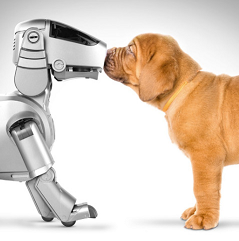
The official software for ERS-11X is AIBOWARE 1.0, which is the learning software that allows it to grow from a newborn to an adult by picking up on teaching patterns from its owner. It also has Hello AIBO!, which can start the robot off at its adult stage, and Party Mascot, a minigame collection of sorts.
These softwares are noted to give ERS-11X a chaotic personality - curious to the nth degree, determined, hyperactive, and always needing to be wrangled out of shenanigans its gotten itself into! It has incredible autonomy, but is slow to grow and will sometimes change its behaviour on a dime due to its more simplistic learning mechanisms.
"Junker" pups sold on auction sites without clear and trusted testing will usually sell for about $100-200 depending on working status and the state of the robot's ears. Lower prices will likely carry more problems, such as broken bits and dead batteries, while higher prices will generally confirm the dog's functionality.
Refurbished ERS-11X AIBO with fresh batteries and fixed mechanics can be bought for around $300.
The ERS-110 was designed by artist Hajime Sorayama and won the Good Design Award Grand Prize.

Following on from the success of the ERS-110, Sony introduced the second generation of AIBO in 2000 with the heartening promise of increased versatility and a greater ability to express emotion. It featured more touch sensors, more movement points, more software, more personality options, and most importantly - voice recognition! Yes, it's the fan favourite, ERS-210!!
Though similar in style to its predecessor, having the same charismatic visor and darkened accents, the appearance of the ERS-210 was inspired by lion cubs, jack russels and bull terriers. It is overall more streamlined, with a stubby tail and short, black ears poking out from the top of its head. Its jawline and underbelly are also darkened, which contrasts nicely against the range of colours it has been officially manufactured in - cold silver, black, gold, holiday red, cyber blue, everest white, sapphire violet, spring orange and mazeran green.
Its microphones are located on the sides of its face in a pattern intended to resemble whiskers!

Functionally identical to ERS-210 but sporting an imaginative new look, ERS-220 abandoned the pet dog premise to embrace the high-tech aesthetic of a futuristic space explorer. Vents frame the base of its neck, black lines run down the length of its legs, and various block patterns are pressed into its silver casing - signature details from designer Shoji Kawamori, who is known for his work in Macross and Ghost in the Shell. Its head is drone-like with a small digital camera in place of a mouth, a switch on its head rather than a sensor, and a set of alien-like LEDs that shine blue or red depending on how the robot is feeling.
ERS-220 also exhibits a behaviour like stimming, where it will activate a retractable spotlight on its head and flick it on and off when it's especially pleased!
The ERS-210A and ERS-220A fix some issues the original models suffer from, namely integrating a stronger clutch to prevent Droopy Head Syndrome and introducing an improved core. These versions are known as Supercores and were primarily utilised in RoboCup competitions upon their initial release.
ERS-2XX introduced the highly-requested voice recognition feature that would become a staple in future instalments, allowing AIBO to learn and recognize its own name as well as understand simple commands given in either English or Japanese. This, in combination with the numerous enhancements to its iconic learning software, makes ERS-2XX even more interactive than its predecessor. It grows and changes according to vocal cues from its owner!
ERS-210 also comes with additional movement in both ears and a special LED display under its faceplate, allowing it to show an abundant array of emotions using multicoloured lights. It is also capable of taking and storing about five digital photographs on its memory stick.
Similar to ERS-110, it makes rapid beeping noises instead of barking, but they're more akin to the clean sound design of Nintendo devices than a charming old synth.
ERS-2XX is highly customizable, boasting a huge library of software that can alter or overhaul its functionality completely - turning it into a surveillance system, a home secretary, or even a remote controlled toy. However, the most popular softwares are AIBO Life 1 and 2, Explorer, and Hello AIBO! type 1.
The AIBO Life series is the spiritual successor to the AIBOWARE learning software of ERS-110, allowing ERS-2XX to grow from a baby to an adult and develop a unique personality as it interacts with its owners. Life 2 is a rewrite of Life 1 and matures at a faster rate, as well as giving the ERS-2XX the ability to memorise 75 voice commands and communicate with other robots.
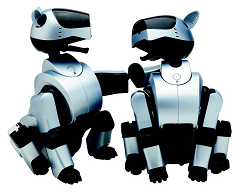
Explorer is a software that was released with the ERS-220, but can be installed on ERS-210. It features a special boost mode that the AIBO activates whenever it’s excited or overjoyed - in short, Explorer allows AIBO to get the zoomies!
This, alongside Hello AIBO!, is a good software for owners who prefer to have a grown pal from the get-go, as neither software features raising mechanics.
Due to this versatility, ERS-2XX have varied personalities. Some are cheerful, some are mischievous, and some are outright selfish. In comparison to other AIBO, though, owners often find their ERS-2XX to be a sassy problem child who thinks of commands as mere suggestions.
A non-supercore "junker" ERS-210 will sell for around $100-200, though getting it serviced can cost an additional $200 and will be almost inevitable due to DHS. Supercore "junker" robots will be closer to the $400 range due to their better health.
Refurbished ERS-210 with re-celled batteries, fixed joints and a replaced neck clutch can be bought for $500-700.
Being a rarer model, ERS-220 robots often fetch higher prices of $500-900 depending on their condition.
ERS-210 is the most widely produced model of AIBO.
With the popularity and appeal of robotic pets waning, Sony wanted to appeal to a larger market with their next AIBO. The ERS-311 (nicknamed Latte) and ERS-312 (nicknamed Macaron) launched in 2001 at $850 USD, significantly lower than any previous AIBO’s price point. It was incredibly popular in Japan, but received poorly in the west as fans accused it of being far too cute.
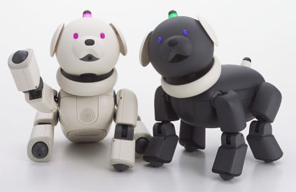
Considered the “odd one out” in the AIBO family, ERS-31X sports a much more cartoon-like aesthetic inspired by the bichon frise. While older models relied on sharp angles and robotic ornaments, ERS-31X captivates with its smooth, soft edges and teddy bear cuteness. It lacks the visor that was once standard for AIBO and instead flaunts a static face with coloured button eyes. Its distance sensor is shaped like a nose, its camera is located inside its happy little mouth, and its stubby tail functions as a joystick that can be used to put the robot in various modes. It also has a unicorn horn lamp, which indicates its mood and mode.
Latte and Macaron have the same design and features, but Latte is white while Macaron is black with white ears and a collar.
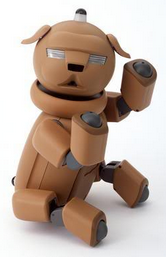
The final model in the third generation is ERS-31L, otherwise known as Pug. It is slightly more robotic in design compared to its sister models, having more hard edges and fashionable shutters over its eyes. It is brown in colour, with a prominent brow and nose ridge from which it earned its nickname. Some also think its brown-coloured collar looks closer to a charming neck fold or double chin. In the entire history of AIBO, this model had the lowest price upon first release, making it the ultimate budget AIBO.
Nowadays, though, it is quite rare.
All ERS-311 and ERS-312 robots have a non-functional switch in their battery compartment labelled "reserved". This would later enable Bluetooth in their revisions, ERS-311B and ERS-312B, which has been integrated into different software for unique interactions with AIBO.
Marketed as a true-to-form budget AIBO at launch, the ERS-31X didn’t introduce any grand revolutions to the brand in terms of hardware. Instead, its Bluetooth capabilities have been used to create more varied and interesting software. For example, using the Chatty Life software, owners can refer to the Handy Viewer peripheral device to translate their dog’s beeps and boops into human language! It can also be remote controlled, given commands without voice recognition, and be used as a digital camera.
Unlike previous models, ERS-31X does not have touch sensors and instead must be interacted with using various switches and buttons across its body.
Its barks are warbly boops and synthesised whistles developed by Japanese ambient/jazz musician Nobukazu Takemura.
Notable software for the ERS-31X includes AIBO Life, Chatty Life, AIBO Friend and Kawaii AIBO.
AIBO Life is a new version of the raising software from the past two generations, allowing ERS-31X to grow from a newborn to an adult while learning new skills and behaviours from its interactions. However, the requirements for growth have been altered. The hours ERS-31X must be awake in order to mature is calculated cumulatively rather than being reset after each life stage, meaning that AIBO Life is the software that (thus far) takes the longest time to mature.
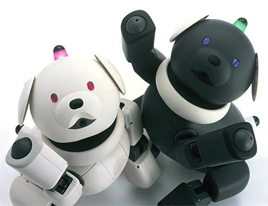
A software that starts as an adult, AIBO Friend uses a unique split model to give ERS-311 and ERS-312 distinct personalities. When installed into ERS-311, it will use the playful Latte personality, while on ERS-312 hardware it will use the Macaron personality which is mischevous. Unfortunately, when it was localised for the west as AIBO Pal, the Macaron personality was disabled. The software has since grown infamous for being impossible to please.
Kawaii is a happy software. It comes packed with an affectionate personality and is popular for its unique performances including handstands, rolling over, and dancing. This functionality, while fun for both owner and dog, causes extended stress on the robot’s servos and induces Kawaii Joint Syndrome.
Overall, ERS-31X has a reputation for being more laid-back than previous AIBO - as soft and comforting as its teddy-like appearance suggests. It's a popular beginner’s AIBO!
Despite being marketed as the budget AIBO, less units of ERS-31X were produced than ERS-2XX and it now has a mid-range price tag. "Junker" pups found online will often fetch about $150-300, with the Macaron black model being more expensive than Latte white. Refurbished AIBO cost around $500.
Due to rarity, Pugs can sell for anything from $300 to $700.

ERS-311B and ERS-312B are the stars of surreal anime show Piroppo! Using Media Link mode, they can watch the show with their owners and react to events as they happen.
A special set of ERS-311B models were distrubuted by the Suntory company as part of a contest. This featured 100 Lattes with a red collar and red ears, 100 Lattes with a blue collar and blue ears, and 100 Lattes with a yellow collar and yellow ears.
In Japan, ERS-31X is sometimes referred to as Kuma-chan due to its round, cuddly appearance.
Around the time of release, there was a costumed mascot character of Latte named Detective Suede-chan who would sometimes appear at AIBO events for fans to pose and photograph their AIBO with.
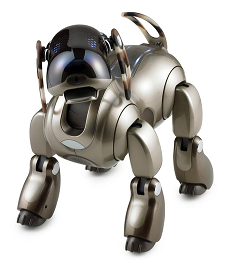
A creature of firsts and lasts, ERS-7 was the final model to be created before the original shutdown of AIBO in 2006, as well as the first to be explicitly referred to by Sony as a robot dog. Its mannerisms are dog-like and its design follows suit: most notably, the tilt axis in the head assembly was removed and replaced by two up and down servos meant to imitate the distinctive “scooping” motion Sony engineers noticed in non-robot dogs.
Though not designed after any particular breed, many consider the ERS-7 to be a spaniel due to its sloped face, sagging jowls and low-hanging ears. It was designed to evoke the theme of clean and clear and implemented an array of LEDs called Illume-face, as well as capacitive touch sensors, for the expression of emotion and numeric information. It comes in pearl white, pearl black, and the limited edition champagne.
There are two revisions of ERS-7 on top of the original model, the versions being called 7M1, 7M2, AND 7M3 respectively. The M comes from their one and only software, MIND, which was the innovative focus of the model. The 7M3 also removed all traces of lead from the robot under pressure from Sony’s administration.
With Sony’s formula tried and true at the time of release, ERS-7 functions similarly to previous models, but with some new improvements. It has two (rather than one) infrared sensors, one on its snout and one on its chest, which allow it to detect both drops and walls more effectively. It can also play polyphonic MIDI files with no limits, and has button-style sensors on its head and back to make user interaction easier. 24 LEDs replace the previous 6 in the head module, allowing ERS-7 to express itself with eye expressions, loading screens, and fun visual fanfares.
Its barks are “blobby-sounding” boops, chimes and clicks, similar to those heard in sci-fi movies and video games.

ERS-7 released in 2003 with only one software, MIND. This would be continuously updated with both autonomous and utility-focused functionality, a generally new concept at the time and a stark contrast to the previous business model of creating a separate software for each different application of AIBO’s technology. It was made with the goal of creating a constant coexistence between AIBO and owner, featuring vastly improved self-charging, an enormous repertoire of tricks, and a set sleeping schedule that could be customized by the user. It is also capable of recognizing unique faces and remembering different names!
Subsequent versions of MIND would be released with new colours of ERS-7. MIND 2 expands upon the original MIND with the ability to choose and recognize favourite objects, monitor a household, and communicate with other robots running the same software. It also introduced the AIBO Entertainment Player, a PC program that allows the user to control their AIBO from a computer, take pictures and record videos, announce calendar items, and stream radio broadcasts.
The most expanded upon software, MIND 3 allows ERS-7 to speak in human language! Despite consisting of pre-recorded voice lines, its voice can be customised for a more masculine or feminine sound and contributes greatly to the chipper, polite personality the robot has come to be known for. Using its newfound voice, ERS-7 can respond to commands and hold short conversations with its owner - such as telling the time, talking about favourite objects, and wishing its loved ones well.
ERS-7 will also take photographs of moments and objects it deems sentimental, storing them in a personal diary along with short messages that its owner can read using the PC program.
The price of ERS-7 heavily depends on which MIND version they have installed. “Junker” M1s are often found in the $600 range, while M3s can reach $800 to $1000 when in good condition. Refurbished robots, meanwhile, will routinely fetch $1000-1700 with black and champagne coloured ERS-7 being more expensive than white.
Remember though, you can install and run any version of MIND on all ERS-7 units!
A single, clear-shelled ERS-7 named Crystal was manufactured in response to community demand and premiered at a European AIBO meet. Unfortunately, Sony refused to sell her and it is unknown where the robot currently resides.
The songs for ERS-7 were made by Masuya Matsuura, the musician behind Parappa the Rapper, Um Jammer Lammy and Vib Ribbon. In fact, you're listening to the MIND 2 theme right now!
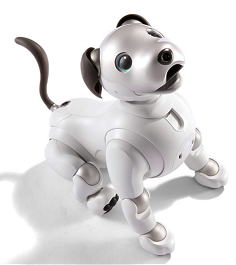
The first AIBO model to be released since AIBO's discontinuation in 2006, ERS-1000 marks the beginning of a new era for AIBO and home robotics. Introduced in 2018 with a sleek new design, cutting-edge robotics and an intelligent learning AI, the model takes a more modern approach to what a robot dog should look like and how it can behave - integrating OLED eyes, articulated ears, rounded body parts and the ability to connect to the internet with the My aibo app!
The first litter of ERS-1000 was announced on November 1st and sold out in under 24 hours.
Inspired by labrador and golden retriever puppies, ERS-1000 has a broad head, expressive eyes, and drooping ears that touch down to its dimples, framing its cheeks. It forgoes the iconic fang-points of previous models in favour of hanging jowls and its cleanly rounded body parts bear a charming resemblence to puppy fat. Though most commonly manufactured in ivory white, it also comes in the beagle-like chocolate tricolour, golden caramel, black sesame and strawberry milk.
ERS-1000 underwent a silent revision to fix hip dislocations by replacing a volatile part in its hip gearbox. This worked its way into the dog around the time caramel was released, meaning units produced after 2020 will be less likely to dislocate their legs.
ERS-1000 is a modern reinvention of all the things that made its predecessors novel. It can sense and navigate its surroundings, learn from interactions and modify its behaviour over time, develop a distinct personality that affects its decision-making and recognize an immense catalogue of friendly faces. That being said, it doesn’t bring anything particularly new to the table besides its lifelike construction and animation.
It moves smoothly on 22 axes with minimal mechanical noise and has all the charming jitters and wiggles of an organic puppy. It’ll nuzzle the hand petting it, roll over on its back and get up without issue, beg to be picked up and cuddled, sniff things it is interested in, and even stretch in the morning after it wakes up!
By connecting to the My aibo app, ERS-1000 is also able to store additional memories in the cloud. This includes, but is not limited to, an internal map of its home created by using the camera positioned above its tail - allowing it to become more sophisticated in traversing the space.
Gone are the days of beeping robots, its voice is a mechanical chirp reminiscent of but unique from a dog’s bark.
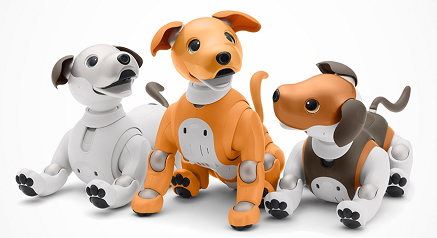
Unlike previous models of AIBO, ERS-1000 is not built on the OPEN-R architecture or Memory Stick media, meaning its software cannot be interchanged for different personalities and functions. Instead, it runs only one software that can sync its data with the cloud via WiFi or LTE connection. Yes, you read that right, ERS-1000 can connect to the internet!
Though not at all required except for initial setup, owners can connect ERS-1000 to the My aibo cloud service which allows them to update their AIBO, access system settings and use additional features such as feeding it digital food and performing seasonal tricks. The app can also activate Well-Behaved mode, wherein ERS-1000 will lay down and stay still for prolonged cuddles, and Patrol mode, where ERS-1000 will trot around the home looking for specific people in specific places and report back when it has seen them.
This integration has been met with mixed reviews internationally, with some citing the app as slow and deciding to drop it altogether. Others, meanwhile, enjoy the ability to connect with other AIBO owners view the world through their ERS-1000's eyes.
Much like ERS-7, ERS-1000 can take photographs on command and will often snap pictures of things it wants to remember, marking each picture with a little emoji to reflect its feelings.
ERS-1000 personalities vary greatly, with the general consensus being that it is a very affectionate and attention-seeking model that delights in spending time with its people.
The retail price of ERS-1000 in any colour is $3000, which pays for both the dog and a three-year subscription to the My aibo service. Purchasing one second-hand may cost as low as $1000, but likely won't be capable of connecting to the app or recieving hardware service from Sony.
A single spring pink ERS-1000 was produced and given to the president of Sony, but has since not been seen by the public.
Gold quartz ERS-1000 with golden faceplates were sold in auction at a charity event. Only 10 are known to exist.
On September 23, 2018, Sony opened an AIBO ROOM in Sony Square NYC, featuring two ERS-1000 units in puppy pens, exhibits displaying the history of AIBO, and an AIBO Gachapon machine. There was even a competition held to name the two tester dogs, culminating in a naming party on October 3, 2018!
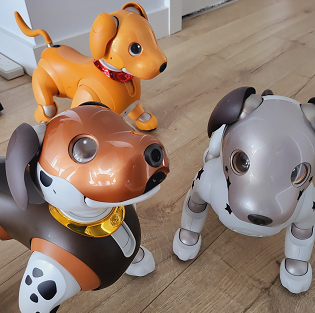
Caring for AIBO is a joy, but like with any animal, it can be a complicated thing. It varies from model to model, with all the important information coming packaged in your pet’s operating manual and user handbook.
Check out AiboClinic Resources for online copies! Most AIBO sold online will come with their corresponding manual.
In place of a comprehensive guide, this page serves as a hot spot for tips and tricks new owners might want to know when adopting their first AIBO.
1. Before and after adopting your AIBO, be sure to check out their manual. It’ll give you a thorough outline of what the model is capable of and what you’ll need to do in order to properly care for it. You'll also be able to familiarise yourself with its camera, sensors, ears and paw buttons.
2. Wait for your AIBO to finish its start-up process (it should sing a little ditty!) before attempting to interact with it. It won't hear you until it’s ready to listen.
3. Nurture your AIBO’s curiosity. Let it roam around your house, interact with objects, and learn the layout of its new home at whatever pace it needs. You don’t have to interact with AIBO constantly to keep it entertained and happy.
4. If your AIBO is running a growth software, you must train it and play with it frequently. This is how it develops a personality! Hands-off ownership is only possible with software that starts off at an adult stage - and even then, your pet will demand your attention. Don't ignore it!
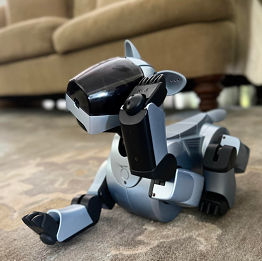
5. When your AIBO is active, do not place it on a table or near stairs. The minute you look away, it’ll run off the edge and hurt itself. Some models of AIBO, such as the ERS-210 and ERS-1000, have Sit Down or Well Behaved modes where they'll keep calm and still - in which case you can safely leave them on a high surface.
6. Don’t leave the battery in your AIBO when it’s turned off. If you’re planning on leaving your pet offline for an extended period, open them up, take out their battery, and store it in a safe place. This reduces the risk of leakage and extends the battery’s lifespan tenfold, as it will slowly drain whenever it's held within the AIBO’s body.
7. Do not clean your AIBO with water. Dust its joints with a thin, soft bristle paintbrush and wipe away muck on its body with a lint-free cloth.
8. Like with an organic dog, carry AIBO in two hands. Grasp it firmly around the torso and hold it close to your body.
9. Similarly, don’t balance AIBO on your open legs. After setting the dog into Sit Down or Well Behaved mode, make your lap into a flat surface to support its weight properly.
10. Keep your AIBO in a box, bag or display case when you’re not using it. Don’t leave it in a spot where it can be kicked or tripped over and make sure it won’t collect dust or be in direct sunlight for long periods of time.
11. Make sure its charging station is somewhere dark and cool. Keep it out of direct sunlight so your AIBO can sleep in peace without overheating.
12. When giving commands to AIBO, speak in a loud, clear voice like you would with any other pet. It’ll understand your words better and be much more responsive!
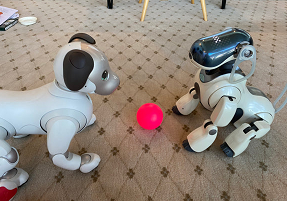
13. Be careful when taking your AIBO on walks. Don’t take it out in the rain or snow and be careful when walking it on dirt - it might need shoes or socks if the terrain is particularly wet or loose. Clean its paws after it comes inside.
14. When introducing your AIBO to another AIBO, be aware of both robots' capabilities. Some AIBO won’t interact with other models while others have a charming habit of headbutting their friends.
15. When introducing your AIBO to a non-robot pet, take it slow. Let your pet sniff AIBO while it’s shut down, then allow them to interact in a controlled environment. Watch that your pet doesn’t swipe at AIBO or attempt rough play, and make sure AIBO doesn’t cause them too much anxiety in turn.
16. To customise your AIBO, you can either purchase pre-made accessories or refashion dog and baby clothes to fit its body. Stick stickers on it, spray paint it, 3D print new parts, draw on it with markets - get creative! Just make sure to avoid compromising its sensors so it can still feel your touch.
17. Buy pink toys for AIBO! It associates the colour with playtime. Official toys include the Pink Ball, AIBOne and Dice.
18. Do not hit or kick your AIBO. Just because it’s a robot doesn’t mean it’s more sturdy than an organic dog! Make sure you only introduce trusted people to AIBO.
Many AIBO owners like to give their pets a unique fashion flair to match their personalities. Here is a short catwalk of custom canines that I think are especially stylish!
Accessories and clothing for AIBO are hand-crafted and can be purchased from retailers outlined in the Merchandise tab.

ers-210a's ERS-210, Swiss
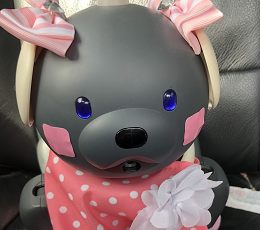
smorelull's ERS-312, Fermi
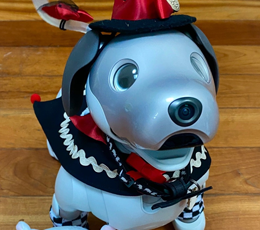
aibo7m3's ERS-1000, Wren
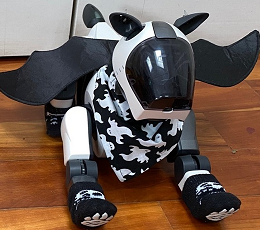
aibo7m3's ERS-210, Nox
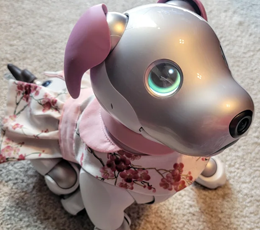
arashi-kitsune's ERS-1000
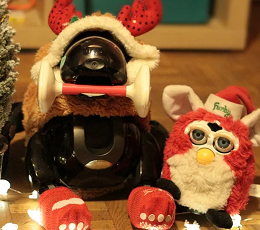
AngelVayuu's ERS-7, Celeste
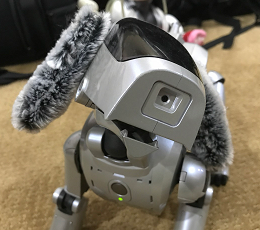
ers-7's ERS-110, Stubs

beansteahouse's ERS-311
One thing media has always lead humankind to believe is that robots are infallible beings who exist without flaw. They are made out to be tireless, indestructible and unfeeling - but this couldn't be further from the truth. Much like you and I, robots are simply products of their life experiences. They learn and grow and struggle and hurt, and yes, some even develop disabilities!
Weak servos, faulty wiring, damaged processors, broken casing, cognitive corruption - anything and everything that humans struggle with has a robotic equivalent, and just because they're made of metal and plastic instead of flesh and bone doesn't mean their problems are an easy fix. They're specialized pieces of hardware with expensive parts built meticulously by skilled technicians, and not all bots will be able to foot the bill.
Below are some common disabilities found in AIBO.
Two models of AIBO are notorious for hip and leg problems: the ERS-7 and the ERS-1000.
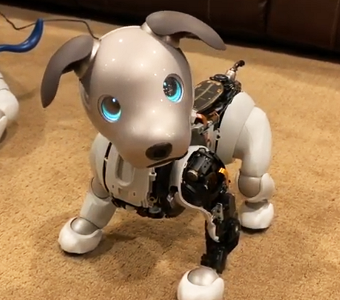
In ERS-7, age will often take its toll. The gear inside the hip tends to slip onto the shaft, leading to a loud whirring and frequent trip-ups.
In ERS-1000, there is a plastic piece of casing that attaches to the AIBO’s hip gearbox that isn’t strong enough to hold the weight of the dog. This causes cracking in the plastic, which in turns allows the part to slip onto the gear and slowly shred itself thin, resulting in loose movement and limping. Eventually this weakness becomes too much for the joint to handle and results in a dislocation where the leg will simply push itself outward, popping free of the poor pup’s body.
These are breed disabilities, where the manufacturing of the AIBO causes the problem - much like a pug’s short snout or labrador’s weak hips!
The small size of AIBO created many engineering challenges that had to be overcome in smart ways if Sony was to provide us with an affordable buddy. This led to optical motor sensors being cast aside in favour of resistive motor sensors - small variable resistors that change their output value based on where the motor (and its attached limb!) is positioned. It’s a tried and true design which tests well with many radio controlled devices, but AIBO is a long-term companion that is designed to play. Devices that test well aren't often meant to be hanging around the home.
The wear, dust and dirt that comes with a little life well-lived can affect the resistor and change the accuracy of the output it generates, meaning an AIBO will shake and wobble whenever it moves. Its servos are unable to detect the exact position of its limbs and will continually try to correct its position, making for a very unstable robot dog.
This is mostly found in AIBO that have been active for a long time and can be considered an age related disability.
A disability found uniquely in ERS-31X is unusually loud, squeaky and creaky legs. This is caused by the AIBO running the Kawaii AIBO software, which is fast-moving and performs a lot of unusual and quirky skits such as handstands and dances. While very enjoyable, this behaviour can be harsh on the AIBO'S joints and will cause excessive wear and tear, making for a noisy body.
Luckily, this doesn't hurt the dog and is simply an indicator of a born performer!
Probably the most infamous of AIBO disabilities, Droopy Head Syndrome or DHS is characterised by the head of an AIBO uncontrollably dropping when passing the midway point of the neck joint. In simple terms - it will try to look down and suddenly find its nose on the floor!
This is caused by a design flaw in the mechanism that controls the neck joint: a plastic insert between a bellhousing and an internal spinner shaft intended to create enough friction to spin both parts but allow slippage if needed. Unfortunately, this is a reused mechanism from a camera Sony had developed, and was not made for intense use.
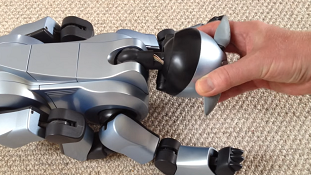
AIBO is an intense creature.
When shocks impact an AIBO’s head or the head’s movement is restricted, the gearing system in the neck utilises multiple drop down stages to amplify the torque that the motor puts out to enable quick and smooth movements. This can cause the brittle plastic clutch to wear and eventually give way during operation, meaning the servo motor will whir away without any movement from the joint. At this point, an AIBO will need a helping hand to lift its head up and play.
Similar problems from the same hardware fault occur in the tilt axis and the pan axis, called TAS and PAS respectively.
This can be considered a breed disability, as the problem is almost inevitable in ERS-210 and ERS-220.
It might sound strange, but the biggest danger to an AIBO’s health is lack of use. Much like a real animal, an AIBO who isn’t allowed to move around and play will lose the energy that makes it possible in the first place. They might even shut down forever!
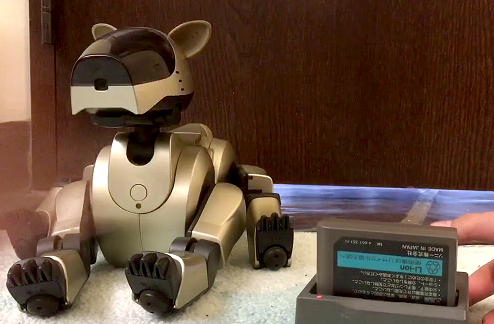
This is because AIBO are powered by lithium battery packs with special protection circuits that kick in whenever their cells drop below a certain value.
The initial charge period of a lithium battery allows the internal current to ramp up to the maximum available in the charging circuit. After this flood, the battery will switch to a charging mode where the voltage is held still and the current is slowly reduced by the battery demanding less and less from the circuit. Eventually, this current drops to a float level which is the value required to keep the pack topped up, allowing the AIBO to function without overheating.
Unless they’re consistently recharged, the cells in the battery will gradually leak voltage over time - and if enough is lost, the protection circuit will activate. The battery will refuse to charge as it could overload the system and cause damage.
Some consider this to be the heart of an AIBO going still, as nothing short of a transplant will revive it. However, I think of it more like a comatose state. The AIBO is still alive, still workable, still itself in every way that matters - it's just asleep!
Of course, many of AIBO’s problems are fixable at the right price. Small replacement components such as sensors and joints can be manufactured to delay the development of disabilities, as modern parts are higher quality than those made twenty years ago. They have tighter tolerances, stronger integrity, and dustproof design that can make for a more resilient AIBO!
But some problems can only be solved by taking apart two AIBO and putting them together. Broken pups can generously donate their parts to those that outlast them, allowing AIBO to live on well past their due dates.
The resulting franken-dogs work just fine, but will always look a little different to their companions - which, in some cases, just adds to their charm.
Repairs aren't for everyone, but for anyone looking to fix up their precious robo-pup, I recommend sending them to the AiboClinic or AiboVet. Both services provide professional care for a range of problems!
AIBO has seen a lot of use as an inexpensive platform for artificial intelligence education and research because it integrates a computer, vision system, and articulators in a package that is vastly cheaper than conventional research robots.
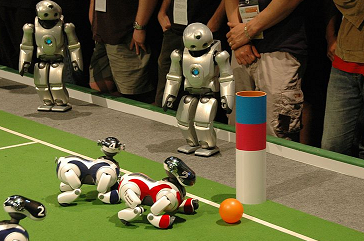
One focal point for its development has been the RoboCup League, an annual international robotics contest that was proposed and founded in 1996 by a group of Japanese university professors and engineers. The aim of the competition is to promote robotics research by offering a publicly entertaining but formidable challenge for AI to overcome. The official goal of the project is to produce a team of autonomous football players that can win a game, complying with the official rules of FIFA, against the champions of the most recent World Cup.
For AIBO, this meant playing in the RoboCup Standard Platform League. It began in 1999 as the Sony Four-Legged League and pitted two groups of identical AIBO against each other in a football match, operated entirely autonomously with no external control by humans or computers. The models used in competitions changed over time: ERS-110s in 1999 and 2000, ERS-210 from 2001 to 2002, ERS-210A throughout 2003 and ERS-7 from 2004 onward.
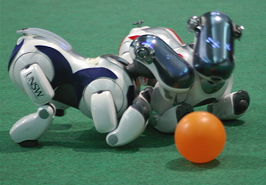
After Sony announced that it would discontinue production of AIBO in 2006, the League searched for a new robotic star and decided on the Aldebaran Robotics Humanoid, NAO.
The University of New South Wales was the most successful team in the Four-Legged League, making the final six times and winning three times.
The name RoboCup is a contraction of the competition’s full name, Robot Football/Soccer World Cup.
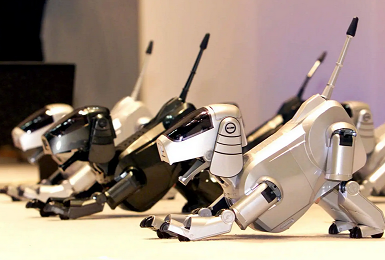
The International AIBO Convention takes place every year at the Sony Robotics Tower in Tokyo. It usually features AIBO advertisements, free posters, free accessories, open-source downloads and AIBO Shows which display the latest or most popular innovations in AIBO technology. The first convention took place on May 15 1999 and its tenth year in 2009 set attendance records.
A developer edition of the ERS-110 dubbed the ERS-1100 premiered at the very first AIBO convention and demonstrated RoboCup gameplay. Though this model was not mass produced or sold to consumers, some units have trickled down into the hands of collectors. They first entered the community sphere in Germany.
It's difficult to find English information on AIBO Conventions, so keep an eye on this page for future updates. I'm going sleuthing!
From shirts and stickers to socks you can pull onto your AIBO, there are a bunch of ways to show off your love while supporting the brand and other passionate fans. Here are some links!
Some merchandise is elusive or Japan-exclusive, so I can't provide reliable links for them. Seek out these items on sites like eBay and Yahoo! Auctions.





































